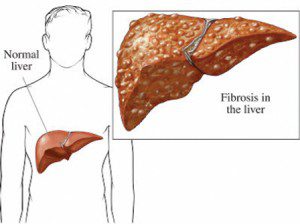By Gastroenterology Associates of S.W. Florida, P.A. –


The liver performs many jobs in your body. It processes what you eat and drink into energy and nutrients your body can use. The liver also removes harmful substances from your blood.
Fatty liver disease is a term used to describe the accumulation of fat in the liver. Fatty liver disease is common, and for most people, causes no signs and symptoms and no complications. But in some people, the fat that accumulates can cause inflammation and scarring of the liver. This more serious form of fatty liver disease is sometimes called steatohepatitis and can lead to liver failure.
Causes
Nonalcoholic fatty liver disease occurs when your liver has trouble breaking down fats, causing fat to build up in your liver tissue. Doctors aren’t sure what causes this. The wide range of disease and conditions linked to nonalcoholic fatty liver is so diverse that it’s difficult to pinpoint any one cause.
Risk Factors
> Certain medications
> High cholesterol
> High levels of triglycerides in the blood
> Malnutrition
> Metabolic syndrome
> Obesity
> Rapid weight loss
> Toxins, and chemicals
> Type 2 Diabetes
> Wilson’s disease
Symptoms
Most individuals are asymptomatic and are usually discovered incidentally because of abnormal liver function tests or hepatomegaly noted in unrelated medical conditions.
Tests and Diagnosis
Tests and procedures used to diagnose fatty liver disease include:
> Blood tests. Liver function tests, including the liver enzymes, may help your doctor make a diagnosis.
> Imaging procedures. Imaging procedures used to diagnose fatty liver include ultrasound, computerized tomography (CT) scan and magnetic resonance imaging (MRI).
Liver tissue testing. If it’s suspected that you have a more serious form of fatty liver disease, your doctor may recommend a procedure to remove a sample of tissue from your liver (liver biopsy). The tissue sample is examined in a laboratory to look for signs of inflammation and scarring. Liver biopsy is done using a long needle inserted through your skin and into your liver to remove liver cells ( needle biopsy).
Types of fatty liver disease
The disease can take several forms from harmless to life-threatening. Forms include:
1. Non-alcoholic fatty liver. It is not normal for fat to build up in your liver, but it won’t necessarily hurt you. In it’s simplest form, nonalcoholic fatty liver disease can cause excess liver fat, but no complications. This condition is thought to be very common.
2. Steatohepatitis. In a small number of people with fatty liver, the fat causes inflammation in the liver. This can impair the liver’s ability to function and can lead to complications.
3. Fatty liver disease associated cirrhosis. Liver inflammation leads to scaring of the liver tissue. With time, scaring can become so severe that the liver no longer functions adequately ( liver failure).
No standard treatment for fatty liver disease exists. Instead, doctors typically work to treat the risk factors that contribute to liver disease. For instance, if you’re obese, the doctor can help you to lose weight through diet and exercise and in some cases medication and surgery. If a drug is causing your fatty liver disease, your doctor may switch you to a different medication.
Steps you can take to control your fatty
liver disease:
Lose weight. If your overweight or obese reduce the number of calories you eat each day and increase your physical activity in order to lose weight. Aim to lose 1 to 2 pounds a week. If you’ve tried to lose weight in the past and have been unsuccessful, ask your doctor for help.
Choose a healthy diet. Eat a healthy diet that is rich in fruits and vegetables. Reduce the amount of saturated fat in your diet and instead select healthy unsaturated fats, such as those found in fish, olive oil, and nuts. Include whole grains in your diet, such as whole wheat breads and brown rice.
Exercise and be more active. Aim for at least 30 minutes of exercise most days of the week. Incorporate more activity in your day. For instance take the stairs instead of the elevator. Walk instead of taking short trips in your car. If you’re trying to lose weight, you might find that more exercise is helpful. But if you don’t already exercise regularly, get your doctor’s ok first and start slowly.
Control your diabetes. Follow your doctor’s instructions, and stay in control of your diabetes. Closely monitor your blood sugar and take your medications as directed.
Lower your cholesterol. A healthy plant based diet, exercise and medications can help keep your cholesterol and triglycerides at healthy levels.
Protect your liver. Avoid things that will put extra stress on your liver. For instance, don’t drink alcohol. Follow instructions on all medications and over the counter drugs.
www.giaswfl.com | 239.275.8882
 Southwest Florida's Health and Wellness Magazine Health and Wellness Articles
Southwest Florida's Health and Wellness Magazine Health and Wellness Articles

